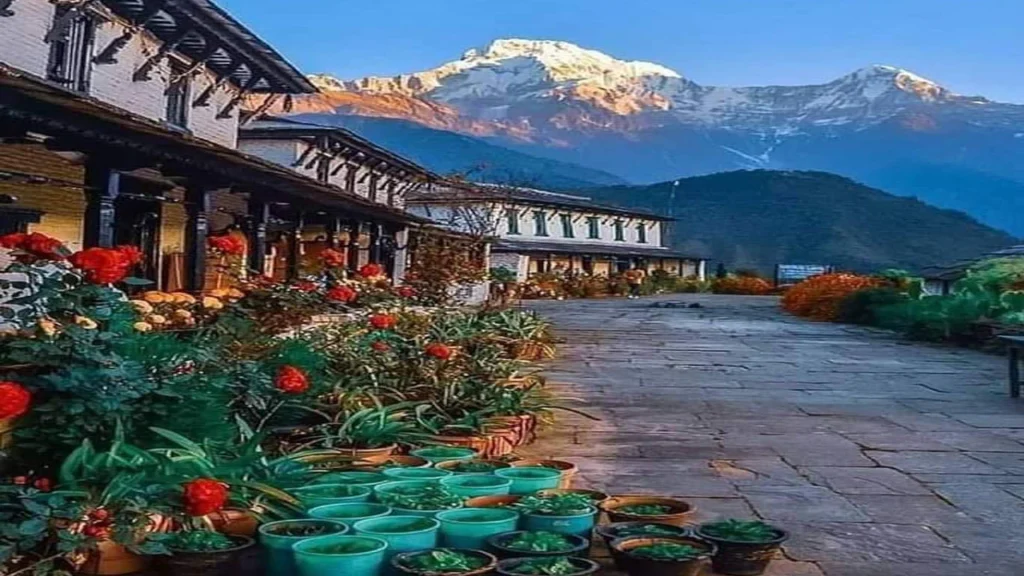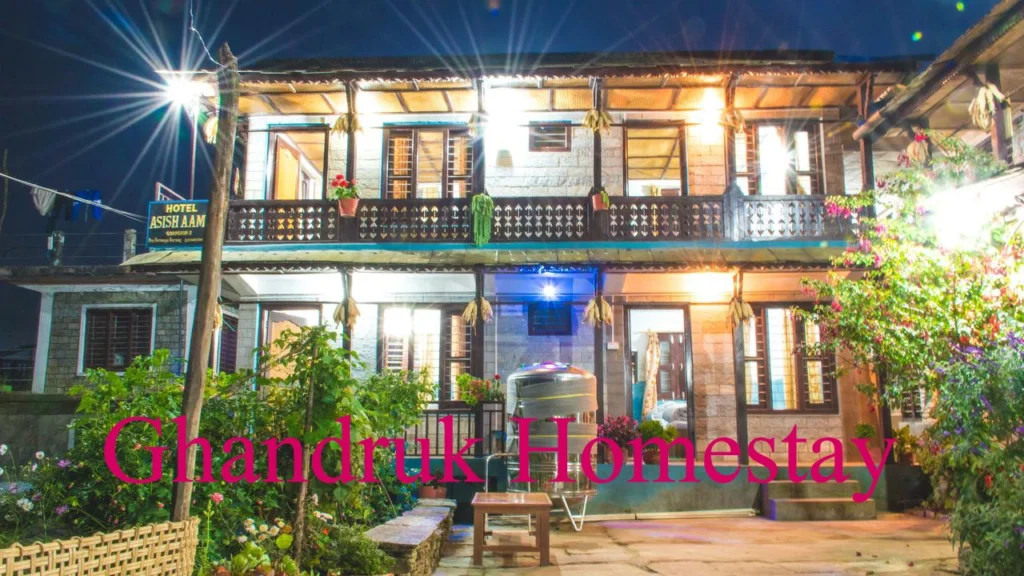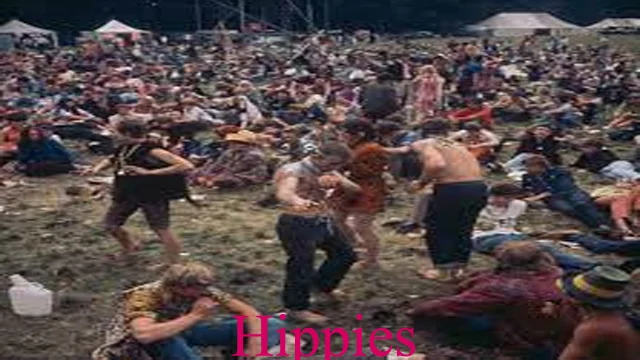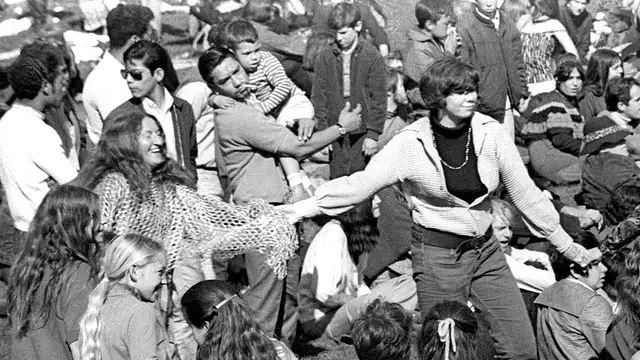Introduction
Ghandruk is a charming and traditional village located in the Annapurna region of Nepal. It is famous for its beautiful views of the Annapurna range, traditional Gurung culture and lifestyle, and rich history.
Ghandruk is home to the Gurung people, an ethnic group of Nepalese origin. The Gurung people have a unique culture and lifestyle that is steeped in tradition and history. Their homes are made of stone and wood, and their clothing is made of bright and colorful fabrics. The Gurung people are also known for their distinctive music, dance and festivals, which are an important part of their cultural heritage.

Tourism is a major source of income for the people of Ghandruk. The village attracts thousands of tourists each year who come to experience its natural beauty, traditional culture and way of life. There are a variety of trekking and hiking trails in the area, including the famous Annapurna Circuit Trek, which takes visitors through breathtaking scenery, lush forests, and traditional villages.
Visitors to Ghandruk can also experience the local culture and lifestyle by staying in a traditional Gurung home, known as a “homestay”. These homestays offer visitors the opportunity to experience local hospitality and learn about the traditions and customs of the Gurung people.
Ghandruk is also known for its rich history. The village was once a strategically important location for the Gurkha army during the British colonial period. There are several old temples and monasteries in the area, which are said to date back hundreds of years.
Importance of Rodhighar in Gurung community in Nepal
Rodhi is an important traditional event in the Gurung community of Nepal. It is a gathering or a social gathering where people come together to share stories, sing and dance. The event is held in the evenings, usually in the courtyard of homes or in community centres.
Rodhi is an opportunity for the Gurung people to maintain their social connections and cultural traditions. It is a time to celebrate the community’s shared history, values, and customs. The event is also a way for people to stay connected to their roots and preserve their cultural heritage.
During Rodhi, participants sing traditional songs, dance to traditional music, and share stories and jokes. This type of event helps to strengthen the bonds of the community and promote a sense of unity.
In recent years, Rodhi has become increasingly popular among tourists visiting the Annapurna region of Nepal. Visitors can attend a Rodhi event and experience the vibrant culture and traditions of the Gurung people firsthand. This type of cultural tourism can help to generate income for local communities and preserve their cultural heritage for future generations.
Overall, Rodhi is an important aspect of the Gurung community’s cultural heritage, and it provides an insight into the rich traditions and values of this fascinating ethnic group in Nepal
Ghandruk Homestay
Ghandruk Homestay is a type of accommodation option for travellers visiting the village of Ghandruk in Nepal. It offers tourists the chance to experience traditional Gurung culture and hospitality by staying with a local family in their home.
Home stays in Ghandruk are a unique and authentic way to experience the local culture and way of life. Visitors have the opportunity to learn about the daily routines and customs of the Gurung people, try traditional Nepalese cuisine, and participate in local activities. The home stays provide a comfortable and welcoming environment and allow travellers to fully immerse themselves in the local culture.
In addition to providing an enriching cultural experience, homestays in Ghandruk also support the local community. The income generated from homestays can provide a source of livelihood for families and contribute to the sustainable development of the village.
If you’re looking for an immersive and authentic cultural experience, a Ghandruk Homestay is a great option to consider during your visit to Nepal.

Which time is best for visit Ghandruk?
The best time to visit Ghandruk is from September to November and March to May. During these months, the weather is clear and sunny, offering good views of the mountains and the surrounding landscapes. The monsoon season from June to August can bring heavy rains and make trekking difficult.
Does snow fall in Ghandruk?
Yes, snow can fall in Ghandruk, especially during the winter months of December to February. The area receives some snowfall due to its high altitude, and the temperature can drop below freezing. However, snow is not common in Ghandruk and the majority of the time it is snow-free, making it accessible for trekking and sightseeing year-round.
Ghandruk Hotels and Price
Ghandruk is a popular tourist destination in Nepal and offers a variety of hotel options to travellers. The prices of hotels in Ghandruk vary depending on the type of accommodation, location, and time of year. Basic guesthouses and budget hotels can start from around 1000-1500 Nepalese Rupees (NPR) per night, while mid-range hotels can cost around 2500-4000 NPR. Luxury hotels and resorts can cost upwards of 6000 NPR per night.
It’s important to note that prices in Ghandruk can change depending on the time of year and demand, so it’s best to check with individual hotels for the latest pricing information. Regardless of budget, travellers can find a variety of hotel options in Ghandruk that offer comfortable and convenient accommodation. Some popular hotels in the area include Ghandruk Hill Resort, Garden Villa Guest House, and Mountain View Inn.
When choosing a hotel in Ghandruk, it’s important to consider factors such as location, amenities, and services. By doing a bit of research, travellers can find the perfect hotel that meets their needs and budget.
How to reach Ghandruk Village?
Ghandruk village is located in the Annapurna region of Nepal and can be reached by several modes of transportation.
By Road:
• Ghandruk can be reached by road from Kathmandu or Pokhara, which are the nearest major cities.
• Private vehicles, taxis, and local buses are available for the journey.
• The drive from Kathmandu to Ghandruk takes around 6-7 hours, while the drive from Pokhara takes around 3-4 hours.
By Air:
• The nearest airport is in Pokhara, which has regular flights from Kathmandu and other major cities in Nepal.
• From Pokhara, travellers can take a taxi or bus to reach Ghandruk.
By Trekking:
• Ghandruk is also accessible by trekking from the nearby trekking routes, such as the Annapurna Base Camp Trek and the Ghorepani Poon Hill Trek.
• This is a popular option for those who want to explore the stunning natural beauty of the region and experience the unique culture of the Gurung people.
Regardless of the mode of transportation, reaching Ghandruk village is a journey that offers scenic views and the opportunity to immerse in the local culture and tradition.
Conclusion
In conclusion, Ghandruk is a unique and fascinating destination that offers visitors a glimpse into the traditional culture and lifestyle of the Gurung people. With its beautiful views, rich history, and friendly hospitality, Ghandruk is a must-visit for anyone travelling to Nepal.

